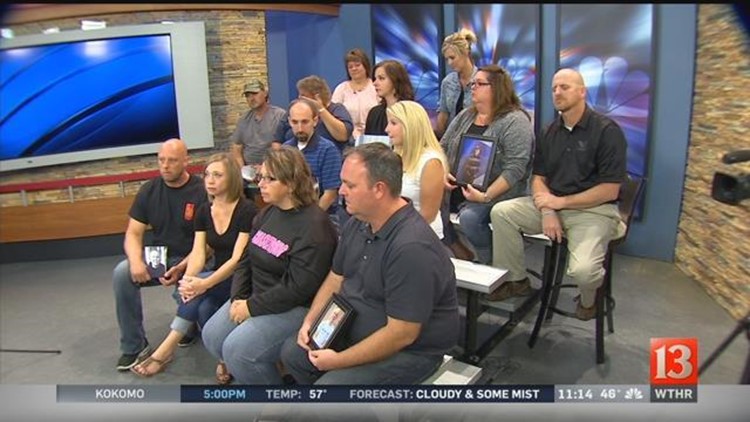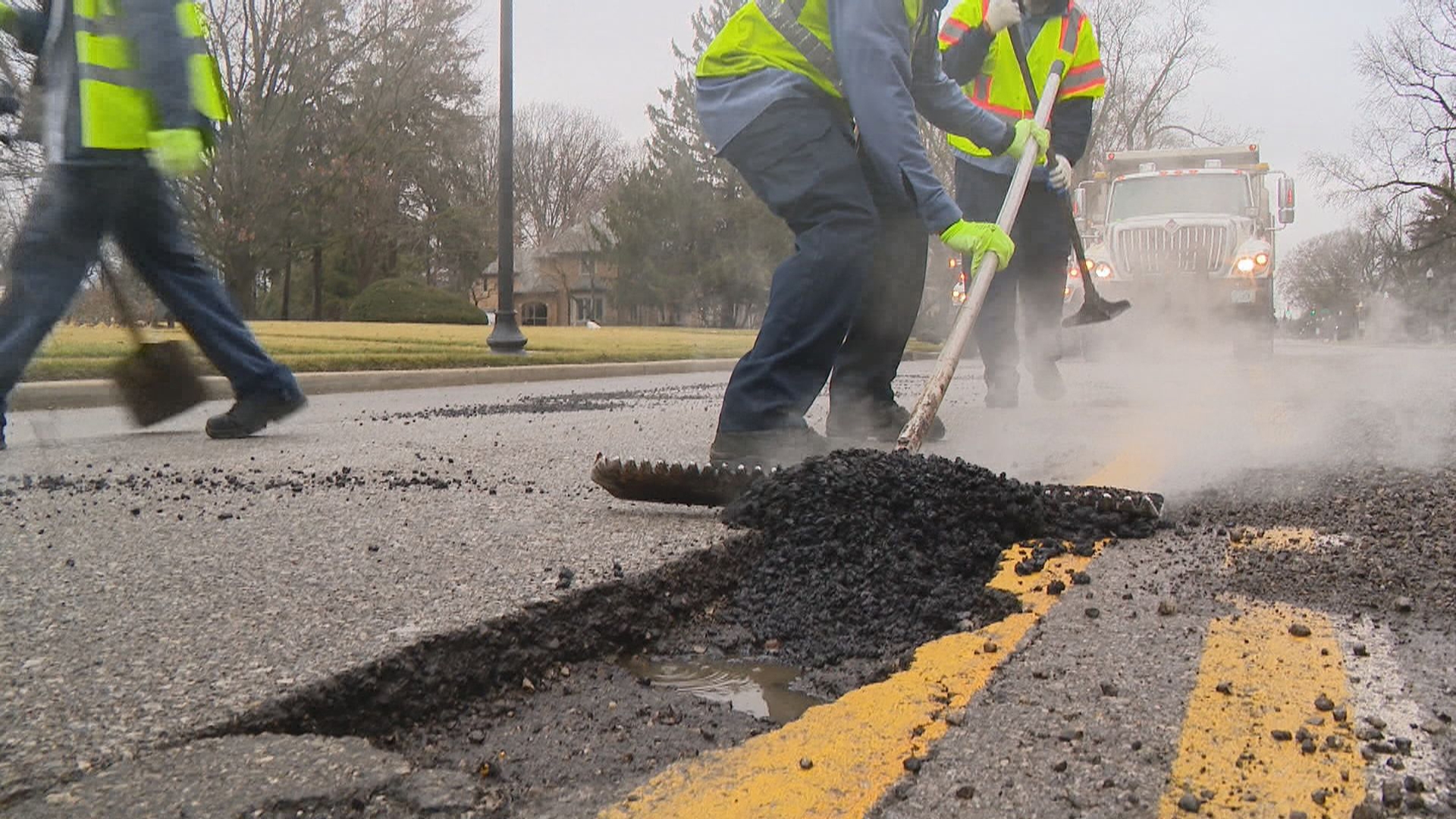JOHNSON COUNTY, Ind. (WTHR) – Strolling along Hurricane Creek, family memories come flooding back for Kari Dotson Findley.
"I've spent many days sitting over there, sitting back here, watching my kids play," said Findley as she pointed out areas along a playground in Johnson County.
 Emma Grace and her mother Kari Dotson Findley.
Emma Grace and her mother Kari Dotson Findley.For 20 years, Dotson Findley called the Johnson County community home.
But months ago, she said goodbye to her life in Franklin, Indiana after her daughter Emma Grace died from Glioblastoma, a rare brain cancer. Emma Grace was just 13.
"I laid in bed with her one day and we cried because she said 'I'm scared'...and I said, 'I'm scared too,'" the tearful mother recalled.
The battle was short for Emma Grace. She died December 18, 2014 just 3-months and 13 days after her diagnosis.
More than 20 Johnson County families have similar stories after a series of childhood cancer diagnoses.
"In your gut you know there's something more than bad luck going on. It has to be," Dotson Findley told 13 Investigates.
Cancer connection or coincidence?
A bleacher full of Johnson County parents who sat down with 13 Investigates to talk about their concerns back in September. Each of the parents held a picture of their child in their hands.
"We have all had to hear 'your child has cancer,'" said Patti Meade, whose son Evan was diagnosed in 2010.
Their children are among the nine cases of childhood cancer the National Cancer Institute says will be diagnosed in Johnson County each year.
The families gathered on the bleachers represent children diagnosed over the last five years.
"I think after 2010 it has just picked up like crazy," said Patti Meade, talking about the increase of children getting sick.
"It is surreal," added Stacie Davidson, whose step-son Zane is fighting Acute Lymphoblastic Leukemia. "It makes me angry because there shouldn't be this many kids," she said looking around at the young faces represented.
 Kaleb Buck (left) and Chase Smith (right) were both 13 when they were diagnosed with Ewing Sarcoma.
Kaleb Buck (left) and Chase Smith (right) were both 13 when they were diagnosed with Ewing Sarcoma.Kaleb Buck and Chase Smith even share the rare diagnosis of Ewing Sarcoma.
"There's only 52 cases in the US a year," explained Chase's father, Brad.
"Just a few miles apart from each other. We both have sons that were about 13 at the time it happened," chimed in Theresa Buck, Kaleb's mother.
The boys were both 13 when diagnosed, the same age as Emma Grace.
Kari Dotson Findley wants answers just as much as the parents whose children are still fighting for their lives. She instinctively knows her presence brings fear for some.
"You know you're sitting there and you know that you're everyone's worst nightmare. You know every single person sitting there is praying that I don't end up like her," she told 13 Investigates.
Tears came easy all around her when she explained why it was important for Emma Grace to be counted.
"When you lose your kid- who didn't get an opportunity to do all of the things she should have done in this life- one of your biggest fears is that people are going to forget. Forget who your kid was, forget how important they were, forget their suffering," she said welling up with emotion.
- The Johnson County Health Department issued a press release Wednesday, Nov. 18th, 2015, two days after the report aired on WTHR. "There has never been data to support that the water is unsafe to drink," health officials said. "Local officials are investigating and will work with state and federal officials to provide updated information as soon as possible." Anyone with questions or concerns is asked to call the county health department at 317-346-4365.

Data from the National Cancer Institute shows Johnson County's 21.9 cancer incidence rate for children under 20 is higher than both the state and national averages of just over 17.
Six other Indiana counties have even higher rates: Hancock, Hendricks, Howard, Marshall, Madison and Boone Counties.
But there's something else happening in Johnson County. There's a connection to one small town.
Growing diagnosis trouble in one small town

Of the 20 families 13 Investigates spoke with, almost half of the children diagnosed with cancer since 2009 grew up or spent significant time in Franklin.
Chelsea Clark, Trevor Hughes, Collin Neese, Sydney Phillips and Karley Smith along with Emma, Evan and Kaleb are all from Franklin.
"It's ridiculous that all these kids have to go through it," said Kaleb who is switching to his fourth chemotherapy treatment in hopes of beating the disease.
Zane Davidson lived in Franklin five years prior to his diagnosis.
"Probably something we were exposed to," he said with a big sign.
It's also a big question for 7-time championship swimmer Chase Smith, who spent extended periods of time in Franklin between the time he was 2 and 10 years old.
“At first I thought it was just a coincidence but just seeing all the diagnosis in the area, it's sort of suspicious," he said sitting pool side.
The families asked 13 Investigates to help.
13 Investigates’ Sandra Chapman took a look at environmental records from the Indiana Department of Environmental Management. What she found raises a whole new set of questions.
Questions that sent 13 Investigates to the Indiana American Water Company, the utility that supplies drinking water to Franklin's 37,000 residents.
Contaminated water wells under investigation
 Stacy Hoffman, Indiana American Water Company's Director of Engineering
Stacy Hoffman, Indiana American Water Company's Director of Engineering"There are areas of concern for contamination," confirmed Stacy Hoffman, the company's Director of Engineering.
He's talking three contaminated water wells in Franklin.
"IDEM has been investigating it for a number of years. We've been working with them, collaborating with them," he told 13 Investigates.
Records obtained by 13 Investigates show dangerous levels of toxins discovered, 3 times the maximum amount allowed of dichloroethylene or DCE in two company wells along Hurricane Creek.
Water company warns contaminants could cause health problems
"Is there something associated with these types of chemicals that make them concerning?," questioned 13 Investigates.
"Above the maximum contaminant levels they could be carcinogenic," Hoffman responded.
"Cancer causing?" asked 13 Investigates.
"Yes," he said without hesitation.
 Hurricane Creek in Johnson County
Hurricane Creek in Johnson CountyAccording to a 2007 letter, attorneys for the water company said dangerous chemicals were discovered migrating from the old Franklin Power Products site into its aquifers along Hurricane Creek.
The plume traveled for years, finally reaching the Webb Well Field.
Even the company's "finished drinking water," treated and ready to be delivered to consumers, had elevated levels near the contamination limit.
The letter warned, "The spread of TCE and PCE through the groundwater and into public drinking water wells certainly poses a serious threat to human health and the environment."
"As we continued to monitor we noticed the levels were increasing and around 2006 we stopped using two of the wells that were on the west side of Hurricane Creek," explained Hoffman.
But for six more years, a third well that had lower levels of the DCE contamination was still used to provide drinking water to the community. Hoffman says the EPA determines the maximum contaminant level for drinking water and that's what the utility followed.
"There is a higher than normal incidence rate of childhood cancers," explained 13 Investigates. "One of the questions being raised is, is it something in our environment? Could it possibly be in the water?"
"We are very concerned about public health and that's why we abide by the EPA regulations and all of our water we deliver to folks meet the EPA standards," Hoffman responded.
The maximum contaminant levels for the chemicals in question are:
- cis-1,2-Dichloroethylene MCL:70 ppb (parts per billion)
- trans-1,2-Dichloroethylene MCL: 100 ppb
- Trichloroethylene (TCE) MCL: 5 ppb
- Tetrachloroethylene (PCE) MCL: 5 ppb
In 2012, INAWC shut down that third well too.
13 Investigates has learned that same year IDEM launched a full scale investigation into the contamination at the Webb Well Field in Franklin.
While IDEM said the water was "safe to consume," it warned that "human exposure to high levels of DCE could cause health problems."1
State cancer registry information lagging
We took what we found to State Epidemiologist Pam Pontones at the Indiana Department of Health.
"Does that seem out-of-character or normal to have that many cases in one small town?" 13 Investigates asked Pontones.
"We would like to determine if there is any pattern. It is very, very rare for an environmental cause of a cancer to be identified," she said.
According to the Indiana Department of Health, there are no studies identifying contaminants that could cause pediatric cancer.
13 Investigates has also learned, even if there was a spiked diagnosis in an Indiana County, the State Department of Health might not know about it. The agency relies on doctors to report pediatric cancer cases. Right now the state can only verify cases through 2013.
"We can't always be sure it's always absolutely complete," revealed Pontones.
Call for action
As IDEM investigates even more contamination near the Webb Well Field, possibly from other sources, the families of those dealing with childhood cancer are asking the State of Indiana to take a closer look.
"We do take those concerns very seriously," said Pontones. "If they would like to contact us to request an investigation, we are very willing," she said.
"There has to be some kind of correlation. It doesn't make sense for us to have a cancer rate this high! It just doesn't. So where does it come from?" said Dotson Findley.
There is now a call for action by the State Department of Health. The Cancer Epidemiologist wants to talk with families in Johnson County, who have had children diagnosed with cancer. The more information, the better the state registry and ability to identify possible connections.
IDEM and the EPA are still investigating the Webb Well Field which is no longer a source for water.
Pinpointing a cause
Pinpointing a cause is often very difficult because of limited research on pediatric cancer. There are red flags that could prompt more action or analysis by the State Department of Health and the CDC.
On Thursday night, 13 Investigates looks into the wave of similar diagnosis and uncovers the reason why experts say Indiana needs to step up environmental monitoring.



